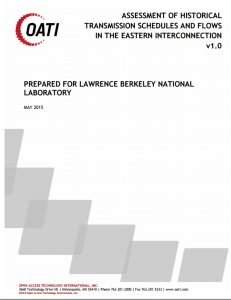Full Title: Assessment of Historical Transmission Schedules and Flows in the Eastern Interconnection, v1.0
Author(s): Open Access Technology International, Inc.
Publisher(s): Open Access Technology International, Inc.
Publication Date: May 1, 2015
Full Text: Download Resource
Description (excerpt):
Understanding and analyzing scheduled and actual flows of electricity on the transmission grid can provide insight into how traditional utilities, power marketers, and others use the system. It can indicate where and when the system is heavily or consistently used, and how schedules align with actual use. The sources of data that provided information on scheduled and actual electricity transfers in the Eastern Interconnection of the United States are widely dispersed among the NERC registered entities.
To address this gap, the U.S. Department of Energy, through the Lawrence Berkeley National Laboratory, issued a contract to Open Access Technology International, Inc. (OATI) to identify and aggregate data describing scheduled transactions and actual flows in the Eastern Interconnection for the year 2011, 2012, and 2013. OATI was directed to aggregate the schedules and actual flows according to the sub-regions within the Eastern Interconnection that had been defined by the Eastern Interconnection Planning Collaborative (EIPC). However, for the 2011, 2012, and 2013 study, the 2010 EIPC diagram was slightly modified to aggregate SPP_N and SPP_S into one SPP region as shown on Figure 2. Also, the pipe between Non-RTO Midwest and PJM was added for the 2011, 2012, and 2013 study as shown on Figure 2. Throughout this study, the schedule and actual flows were calculated and presented on the load duration curves in Section 3.2 were derived from the modified diagram as shown on Figure 2.
This report documents OATI’s data collection and aggregation, and presents the data. Section 2 describes the sources for the data collected by OATI, and the means by which they were aggregated. It introduces the EIPC sub-regions and provides detailed descriptions for how data collection and aggregation were implemented for each sub-region. Section 3 presents the data representing scheduled and actual flows between the EIPC sub-regions OATI’s analysis. It first describes the transmission system utilization metrics among the sub regions and presents the results of these metrics in Section 3.1. Section 3.2 then presents the loading of the paths between sub regions, organized as load duration curves.
